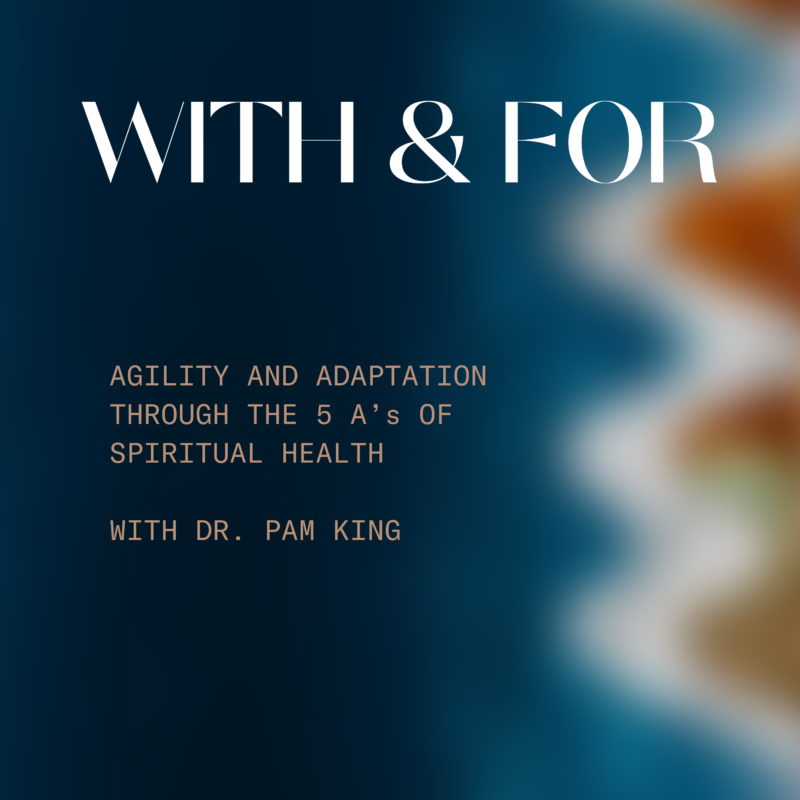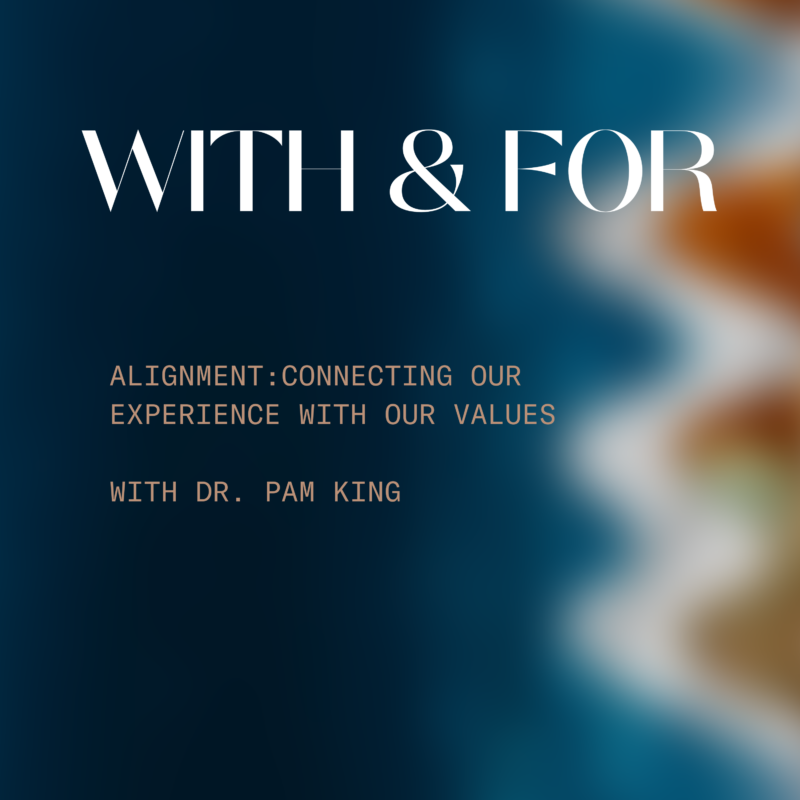This transcript was generated automatically. It may contain errors.
Pam King: I’m Dr. Pam King, and you’re listening to With & For, a podcast that explores the depths of psychological science and spiritual wisdom to offer practical guidance towards spiritual health, wholeness, and thriving on purpose.
Jill Westbrook: Hello, dear listeners, Jill Westbrook here. I produce With & For, and I’m Senior Director at The Thrive Center, and you’re listening to our current series from Pam King on the 5 A’s of Agility for Spiritual Health. Before we get into the third step of the 5 A’s, just another brief reminder that Season 2 of With & For is dropping on January 6, 2025, but we are actively bringing you new content we haven’t aired before throughout the fall, sharing shorter clips, practical features, and other talks and interviews with Pam King.
Also, during this on ramp to Season 2, We’d be so grateful for your support. If you haven’t already, would you consider sharing an episode that you found helpful and then rating and reviewing our show on Apple podcast or Spotify? It’s a simple way to help us expand and grow our within for community.
Thank you to this point, Pam introduced the 5 A’s of Agility for Spiritual Health and we’ve looked closely at Steps 1 and 2. attunement, and awareness. We’re going in order, so if you haven’t heard those yet, I’d really recommend starting there.
In today’s episode, Pam King continues by considering alignment, becoming even more reflective, drawing connections between our thoughts and emotions and our beliefs. values, habits, and the experiences that shape us. This is the step where we look for our intentions and expectations and hold them up to our raw experiences and the possible meanings associated with them.
We begin by identifying what’s true or what’s false in our feelings and thoughts so we can more clearly move toward our purposes. Here’s Pam on step three of the 5 A’s of agility for spiritual health alignment. Thanks for listening.
Pam King: The third step in the 5 A’s is align. The last two, attunement. and awareness are much more receptive and becoming attuned and aware of oneself. Alignment, we begin to shift our posture and being more proactive. Alignment involves aligning the insights that you gained from taking inventory and attuning to your feelings and becoming aware of their meanings of then aligning these feelings to your ideals and your values.
And what you assume matters. Most of us. in daily life have some sense of what matters and what our values are and what brings us most joy, what our purpose and what we’re heading towards. But we all go through transitions of life. I definitely have days when those things are less clear, where we’re making sense of what are these ideals or values that we want to pursue.
Alignment is the moment where we take stock of what we’ve gained from attuning and becoming aware in seeing how they might either confirm what we assumed mattered, what brings joy, what brings meaning to our life, or how they might inform ways we need to tweak or alter the goals, the values that have informed our lives.
So, for example, at work, perhaps your boss altered your job and you were really sad. They thought they were making your work easier, but they took away a task and you ended up feeling sad. That sadness you might become aware indicates that the task that you were doing and that part of the job that they’ve removed actually really matters to you.
And that’s one of your core strengths or one of your skills or one of your passions that you actually want to be aligned with. So alignment is that moment where we take inventory of what is and what we ideally want to pursue and to see how they’re aligned. We either alter the ideals of what we’re headed towards or we confirm them.
But it’s a way of enabling us to become more insightful about what we’re pursuing.
So in order to practice alignment, which can be pretty heady. The idea is to daily take time, make space for you to consider how your actions and the feelings that they lead to, how they are aligned with the values that guide your life. How you spend your time, is that really aligned with what you say matters most?
Furthermore, offer in prayers, you know, asking God for help to provide for you what you need to pursue those values and goals in your life.
This can happen on a daily basis, and I know for me it’s really important to reflect at least quarterly on my major life goals, and to take inventory to see how my daily life, my lived experience, my emotional health and well being, my relationships, how are all those aligned with the major life goals.
I grew up in a family that was very goal oriented and my dad always encouraged me ever since high school to have quarterly goals or annual goals to think about. My academic life, my spiritual life, my social life, and my personal well being. And so I grew up always being mindful of quarterly or annual goals in different dimensions of my life.
And this practice of alignment is a way to take that into a daily practice. And it’s not just my dad’s idea. There is a ton of research on Living with integrity, living aligned with what matters, living a self concordant life. When our life is aligned to what truly matters, that is when we experience the most joy.
And not just happy joy, but enduring joy. So that when life doesn’t go as planned or as things shake up or frustrations happen when we are living out of our deepest values. That brings a resilience and it brings a direction and stability to our lives.
Jill Westbrook: Thanks for listening friends. Next week, Pam will walk us through activation, putting this internal work into concrete action. Until then you can find a wealth of practices and resources on our website, thethrivecenter.org. And if you haven’t already subscribed to With & For to catch each of our weekly episodes this fall, see you next week.
Pam King: With & For is a production of The Thrive Center at Fuller Theological Seminary. For more information, visit our website, thethrivecenter.org, where you’ll find all sorts of resources to support your pursuit of wholeness and a life of thriving on purpose.
I am so grateful to the staff and fellows of the Thrive Center and our With & For podcast team. Jill Westbrook is our Senior Director and Producer. Lauren Kim is our Operations Manager. Wren Jeurgensen is our Social Media Graphic Designer. Evan Rosa is our Consulting Producer. And special thanks to the team at Fuller Studio and the Fuller School of Psychology and Marriage and Family Therapy.
I’m your host, Dr. Pam King. Thank you for listening.
 Dr. Pamela Ebstyne King
Dr. Pamela Ebstyne King
Pamela Ebstyne King is the Executive Director of the Thrive Center and the Peter L. Benson Professor of Applied Developmental Science in the School of Psychology at Fuller Theological Seminary. Her life’s purpose is to help people thrive. To this end, her academic work focuses on psychological and theological perspectives of human thriving and social flourishing. Her psychological research focuses on spiritual and moral development; the role of transcendent beliefs, narratives, and emotions in virtue development; and environments that promote thriving for diverse people. TheThriveCenter.org translates research into resources that promote wholeness, thriving, and spiritual health, and she is the host of the With & For podcast.
Episode Summary
“When our life is aligned to what truly matters, that is when we experience the most enduring joy.”
In this episode, Dr. Pam King explains the 3rd step in the 5 A’s of Agility for Spiritual Health. Alignment is the process of becoming more reflective, drawing connections between our thoughts and emotions—and our beliefs, values, habits, and the experiences that shape us.
This is the step where we look for our intentions and expectations and hold them up to our raw experiences and the possible meanings associated with them. We begin by identifying what’s true or what’s false in our feelings and thoughts so we can more clearly move toward our purposes.
ANNOUNCEMENT: With & For Season 2 launches on January 6, 2025!
Show Notes
- “Alignment involves aligning the insights that you gained from taking inventory and attuning to your feelings and becoming aware of their meanings of then aligning these feelings to your ideals, your values, and what you assume matters.”
- What matters to you?
- Taking stock of what we attuned to, and what we became aware of
- How do we align what is with what we want?
- How to practice alignment
- How do you spend your time?
- Reflecting regularly on life goals
- “When our life is aligned to what truly matters, that is when we experience the most enduring joy.”
- Resilience and stability
About the Thrive Center
- Learn more at thethrivecenter.org.
- Follow us on Instagram @thrivecenter
- Follow us on X @thrivecenter
- Follow us on LinkedIn @thethrivecenter
About Dr. Pam King
Dr. Pam King is Executive Director the Thrive Center and is Peter L. Benson Professor of Applied Developmental Science at Fuller School of Psychology & Marriage and Family Therapy. Follow her @drpamking.About With & For
- Host: Pam King
- Senior Director and Producer: Jill Westbrook
- Operations Manager: Lauren Kim
- Social Media Graphic Designer: Wren Juergensen
- Consulting Producer: Evan Rosa
Explore More

Meaning
Living at the Intersection of Joy, Meaning, and Balance
Research indicates spirituality links meaning to joy, and may provide insight into the balance and purpose we seek.

Pamela Ebstyne King, Ph.D.
Agility and Adaptation through the 5 A’s of Spiritual Health
How can we cultivate agility and adaptivity in our chaotic, shifting times? Dr. Pam King offers a research-backed cycle of practices to incorporate into the rhythms of your daily life—helping you navigate change and work through life’s obstacles. She calls them the 5 A’s of Spiritual Health: Attunement, Awareness, Alignment, Activation, and Assessment.

Agility
A Practice: Values-Based Living
Identifying your values to figure out how you would like to show up in pursuit of what matters most to you
